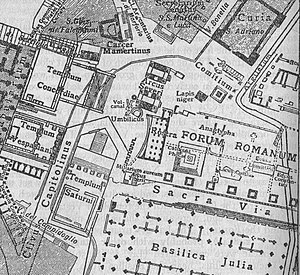
Back Вулканал Byelorussian Vulcanal Catalan Volcanal German Volcanal Spanish Volcanal French Volcanale Italian Vulcanal Dutch Volcanal NB Vulcanal Portuguese Вулканал Russian


The Shrine of Vulcan (Italian: Volcanale), or Vulcanal, or Volcanal, was an 8th-century BC sacred precinct on the future site of the Roman Forum in Rome, modern Italy.[1] Dedicated to Vulcan, the Roman god of fire, it was traditionally considered to commemorate the spot where the legendary figures Romulus and Tatius concluded the peace treaty between the tribes known as the Latins — on the Palatine Hill — and the Sabines — on the Quirinal and Esquiline.[2] This famous merger of the hill-villages was said to be the foundation of the Roman state.[3]
- ^ Coarelli, Filippo (1983), Il Foro Romano, 1: Periodo arcaico, pp 164 ff.
- ^ Grant, Michael (1970), The Roman Forum, London: Weidenfeld & Nicolson; Photos by Werner Forman, pg 214.
- ^ Dionysius of Halicarnassus, Roman Antiquities, II, 50, 54.